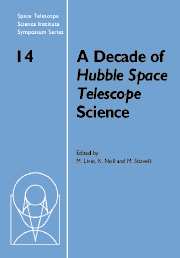Book contents
- Frontmatter
- Contents
- Participants
- Preface
- HST studies of Mars
- HST images of Jupiter's UV aurora
- Star formation
- SN1987A: The birth of a supernova remnant
- Globular clusters: The view from HST
- Ultraviolet absorption line studies of the Galactic interstellar medium with the Goddard High Resolution Spectrograph
- HST's view of the center of the Milky Way galaxy
- Stellar populations in dwarf galaxies: A review of the contribution of HST to our understanding of the nearby universe
- The formation of star clusters
- Starburst galaxies observed with the Hubble Space Telescope
- Supermassive black holes
- The HST Key Project to measure the Hubble Constant
- H0 from Type Ia supernovae
- Strong gravitational lensing: Cosmology from angles and redshifts
Strong gravitational lensing: Cosmology from angles and redshifts
Published online by Cambridge University Press: 13 August 2009
- Frontmatter
- Contents
- Participants
- Preface
- HST studies of Mars
- HST images of Jupiter's UV aurora
- Star formation
- SN1987A: The birth of a supernova remnant
- Globular clusters: The view from HST
- Ultraviolet absorption line studies of the Galactic interstellar medium with the Goddard High Resolution Spectrograph
- HST's view of the center of the Milky Way galaxy
- Stellar populations in dwarf galaxies: A review of the contribution of HST to our understanding of the nearby universe
- The formation of star clusters
- Starburst galaxies observed with the Hubble Space Telescope
- Supermassive black holes
- The HST Key Project to measure the Hubble Constant
- H0 from Type Ia supernovae
- Strong gravitational lensing: Cosmology from angles and redshifts
Summary
It is rare in astronomy to have a purely physics-based technique for studying the distant universe. Rooted in General Relativity, the image distortion and time delay of light from distant objects caused by foreground gravitational lenses offers such a window on the universe. Using only combinations of measured redshifts, angles, and arrival times of source intensity fluctuations, lensing observations can probe the mass distribution of the lens, the rate of expansion of the universe (the Hubble constant), the acceleration of expansion (dark energy), and the total amount of matter in the universe. The HST has made and will continue to make unique contributions to this new window on the universe.
Introduction
The universe is not as it seems: distant galaxies and quasars are in the wrong places. Their apparent positions on the sky have moved relative to where they would normally appear, and the culprit is mass-energy. Specifically, a massive object (a star, a galaxy, a cluster of galaxies) will warp space-time around it, causing light rays to bend as they pass by. If a mass concentration lies between us and a distant source, that source will appear in an altered location. The effect is called gravitational lensing, and it also systematically distorts the images of resolved sources like galaxies.
- Type
- Chapter
- Information
- A Decade of Hubble Space Telescope Science , pp. 247 - 260Publisher: Cambridge University PressPrint publication year: 2003



